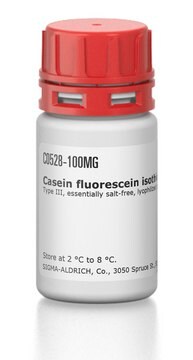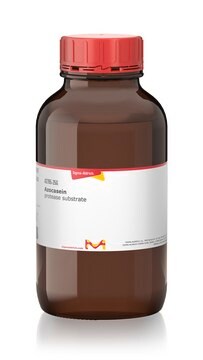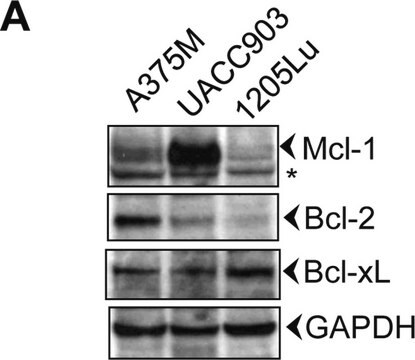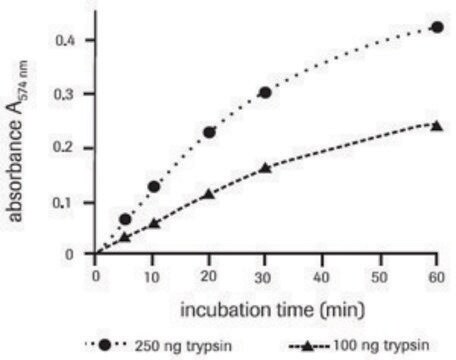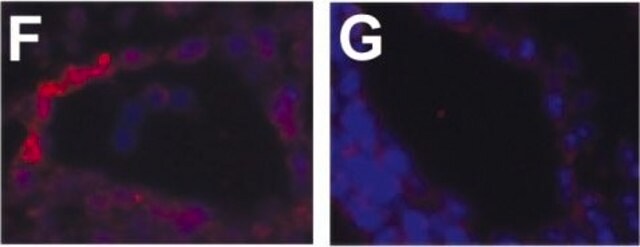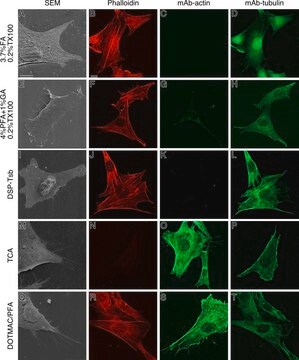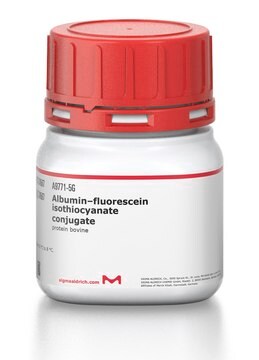추천 제품
유형
Type II
양식
essentially salt-free, lyophilized powder
라벨링 범위
20-50 μg FITC per mg solid
solubility
water: 5 mg/mL, clear to hazy, yellow to orange
저장 온도
2-8°C
유사한 제품을 찾으십니까? 방문 제품 비교 안내
일반 설명
Casein is a major milk phospho-protein and constitutes about 80% of the total protein content in milk. Bovine milk is composed of four types of casein such as, αS1, αS2, β, and κ. Casein exists as micelles in milk.
애플리케이션
Casein fluorescein isothiocyanate from bovine milk has been used:
- as a substrate for semi-quantitative analysis of protease in Arabidopsis cells
- to determine the caseinolytic activity of secreted LasB (elastase), alkaline protease and protease IV
- for determining the SpeB (cysteine protease) proteolytic activity in Streptococcus pyogenes cells
highly sensitive protease substrate
생화학적/생리학적 작용
Casein micelle system is involved in the prevention of pathological calcification of mammary glands.
Storage Class Code
11 - Combustible Solids
WGK
WGK 3
Flash Point (°F)
Not applicable
Flash Point (°C)
Not applicable
개인 보호 장비
Eyeshields, Gloves, type N95 (US)
이미 열람한 고객
Thomas S Murray et al.
Journal of medical microbiology, 59(Pt 5), 511-520 (2010-01-23)
Pseudomonas aeruginosa is an opportunistic Gram-negative pathogen capable of acutely infecting or persistently colonizing susceptible hosts. P. aeruginosa colonizes surfaces in vitro by either biofilm formation or swarming motility. The choice of behaviour is influenced by the physical properties of
Invited review: Understanding the behavior of caseins in milk concentrates
Corredig M, et al.
Journal of Dairy Science, 102(6), 4772-4782 (2019)
Mark F Mabanglo et al.
Communications biology, 2, 410-410 (2019-11-23)
Bacterial ClpP is a highly conserved, cylindrical, self-compartmentalizing serine protease required for maintaining cellular proteostasis. Small molecule acyldepsipeptides (ADEPs) and activators of self-compartmentalized proteases 1 (ACP1s) cause dysregulation and activation of ClpP, leading to bacterial cell death, highlighting their potential
Hui Gao et al.
Plant physiology, 173(1), 219-239 (2016-11-23)
Aspartic proteases are a class of proteolytic enzymes with conserved aspartate residues, which are implicated in protein processing, maturation, and degradation. Compared with yeast and animals, plants possess a larger aspartic protease family. However, little is known about most of
Michael Maurer et al.
Cell chemical biology, 26(8), 1169-1179 (2019-06-18)
ATP-driven bacterial AAA+ proteases have been recognized as drug targets. They possess an AAA+ protein (e.g., ClpC), which threads substrate proteins into an associated peptidase (e.g., ClpP). ATPase activity and substrate selection of AAA+ proteins are regulated by adapter proteins
프로토콜
Our General Protease Assay Procedures and Substrates overview.
자사의 과학자팀은 생명 과학, 재료 과학, 화학 합성, 크로마토그래피, 분석 및 기타 많은 영역을 포함한 모든 과학 분야에 경험이 있습니다..
고객지원팀으로 연락바랍니다.